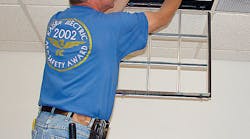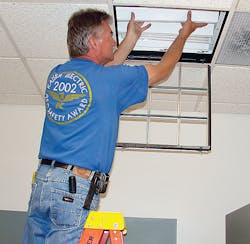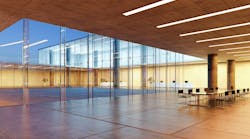With the advent of technological and environmental advances in lighting, retrofits have been on the upswing for years. Many consider the cost efficiency of extending the life of an existing asset as a good rationale for retrofitting an existing luminaire instead of replacing it with a new one. However, you must consider several important factors to help ensure a successful retrofit.
In concept, a luminaire retrofit seems relatively simple. In practice, the broad variety in luminaire and kit designs — coupled with the varying needs of involved stakeholders — all contribute to the complexity of a retrofit. These stakeholders include the original equipment manufacturers (OEMs), independent contractors/installers, facility owners, and authorities having jurisdiction (AHJs).
The basics
What are retrofits, and why are they so popular? Retrofitting helps get additional time and value out of existing infrastructure by updating it with new components. For example, updating older traditional (e.g., incandescent, fluorescent, and HID) lighting with LEDs offers a broad range of benefits, including financial (e.g., longer life, reduced maintenance and electric costs), environmental (e.g., no UV emissions, no mercury, no recycling requirements), and functional (e.g., dimmable, color control, built-in surveillance features, customizable intelligent control options).
While lighting retrofits offer the opportunity for cost savings from reduced energy use and longer maintenance cycles, they also provide facility managers with additional time to evaluate the direction of technological growth prior to making substantial financial investments in new assets. Because LED technologies are continuing their rapid evolution, a smaller investment in terms of a retrofit that extends the functional life of existing lighting equipment by five to 10 years is often a practical alternative to the cost and disruption of a full replacement.
Retrofits and compliance
One of the questions that is often asked about retrofitting is, “How does retrofitting a product affect its certification?” The short answer is it doesn’t — because the certification (listing) mark applies to the product at the time it leaves the factory. The more relevant — and challenging — question to ask is, “Will a retrofitted product comply with applicable standards and installation codes?” Even the simplest modification to an installed luminaire can potentially result in unintended noncompliance issues and even significant safety impacts.
About “listing”
First, some basics: What does “listing” even mean? It’s important to note that the National Electrical Code (NEC) definition of “listing” differs a bit from how a third-party certifier like UL uses the term. The NEC definition is quite literal — it means that an independent agency or testing laboratory has placed a specific product on a “list” that can be referenced to verify its compliant status. Certifiers such as UL have a more narrow and rigorous definition of “listed,” which typically also involves oversight of the product’s ongoing production.
While retrofit kits and their associated certification programs have existed for some time, the 2014 edition of the NEC formally adopted a definition for “retrofit kits.” There were two main drivers for this action: 1) recognition of the growth in activity regarding LED lighting; and 2) a desire to establish a regulatory structure for the rules around these kits. Sections 410.6 and 600.3 of the NEC were also amended to include retrofit kits in the group of items that “…shall be listed” along with luminaires and signs, respectively.
The triad of safety
A retrofit kit consists of three key elements:
- Part 1: the existing (previously installed) luminaire
- Part 2: the retrofit kit components
- Part 3: instructions for completing the retrofit successfully.
First, it’s important to check that the host luminaire complies with applicable end-product requirements (e.g., UL 1598, Standard for Luminaires). The certifier’s mark symbolizes that a sample product of the host luminaire complied with the applicable standard at the time of its manufacture regarding protection against fire, electric shock, and mechanical hazards. Product installation and prior repairs are expected to have been performed by a qualified electrician familiar with national and local electrical code requirements.
Secondly, it’s essential to use a certified luminaire retrofit kit to help ensure a safe and compliant retrofit project. UL certifications for luminaire retrofit kits cover the kit’s components, labels, and instructions. These kits are intended for field installations and are to be installed only on listed products by qualified installers. The UL certification mark on a kit indicates to the installer, facility owner, and property manager that a sample version of the kit and its components have been evaluated by UL for use with the identified luminaires. It also indicates that when the kit is installed in accordance with its markings and instructions, the converted luminaire complies with UL 1598.
Now let’s say a few words about the installers. There is heavy reliance on basic assumptions about the qualifications and competence of installation personnel:
- They have the ability to follow the kit instructions.
- They follow industry-accepted safety and protection guidelines.
- They understand and apply the applicable NEC provisions.
How to select the right retrofit kit?
There is a large variety of retrofit kits available in the marketplace today; therefore, it’s imperative that you follow these guidelines.
Review the installation instructions prior to selection — UL-certified retrofit kits are required to be provided with installation instructions. Many manufacturers provide more details about their kits on their own website. Reviewing the installation instructions prior to selecting a kit can be very valuable, since the instructions reveal the level of installation complexity. If a project involves hundreds of retrofits, the time required per retrofit can become a key consideration. UL’s standards have detailed requirements regarding the content and usability of installation instructions, requiring step-by-step instructions and pictures as appropriate. There is also a requirement to provide a complete parts list as part of the installation instructions.
Confirm compatibility of dimmers and controls — Most of the fluorescent lighting that is being replaced via an LED retrofit will have standard ON/OFF controls, since few older fluorescent ballasts were capable of handling dimmer inputs. If a project is replacing incandescent luminaires — or if new controls are being installed along with the LED kits — it’s important to verify compatibility for the selected kits with any planned daylight controls, timers, dimmers, and similar devices. Currently there is no standardization for lighting controls compatibility. Therefore, it’s important to look for a designated “matched pair” relationship between the dimmer/control and the luminaire. This means looking for a specific claim of compatibility where the LED luminaire or the control (or both) specifically refer to the other by manufacturer and model number in the specifications sheet.
Evaluate photometric data — Some of the main reasons to undertake a retrofit project are to improve lighting performance of a space, to maintain the existing photometric performance while improving energy efficiency, or to allow the use of more sophisticated controls. This means that photometric data should be evaluated prior to kit selection. This data should be available directly from the respective manufacturer, particularly if the kit carries an Energy Star, DLC, CEC, or Lighting Facts label. For any project (interior or street lighting), the photometric data evaluation should include verification that the data is representative of the specific fixture being updated, and that the data meets the performance requirement of the job. Note: UL’s safety certification program does not require evaluation of the photometric performance of a kit, although UL does provide testing services for programs offered by other agencies.
Four key considerations for kit installation
The installer is responsible for adhering to kit installation instructions and applicable provisions of the NEC. Be sure to:
- Always read the installation instructions.
- Always de-energize the circuit.
- Know the rules in the specific jurisdiction; some have different requirements for determining who is a qualified installer.
- Properly handle and dispose of hazardous components, especially fluorescent lamps containing mercury.
A few important safety markings are required to be placed on a retrofitted luminaire:
- Clearly visible notification not to put a standard fluorescent lamp back into the retrofitted fixture.
- Identification of lamp replacement type/model, along with manufacturer and ordering information.
The lamp installation instructions or a separate sheet should contain text or a diagram showing how the supply connections were made to the lampholders to help ensure a future replacement lamp matches the system’s electrical configuration.
Last but not least — AHJ approval
Generally, commercial retrofit projects are subject to a local or state permitting process that involves an AHJ (sometimes referred to as the electrical inspector). The inspector will be looking for use of appropriately certified equipment, and whether or not the equipment has been installed in accordance with its ratings and instructions. UL supports both the installer and the AHJ in this process by providing access to UL staff to resolve any questions or uncertainties. In cases where the kits used are not certified, or the AHJ remains unsatisfied with the overall compliance of a finished project, UL’s field evaluation program is available to resolve any specific identified concerns.
If planned and executed correctly, luminaire retrofits can be an excellent method for extending the life of lighting assets, reducing facility energy costs, and improving lighting performance in a space.
Shulman is a principal engineer with UL in San Jose, Calif. He can be reached at [email protected].
SIDEBAR: Retrofit Resources
UL’s online certification directory for LED retrofit kits:
http://iq.ul.com/ssl
More information on how UL supports retrofitting:
http://industries.ul.com/lighting/retrofit-kits




